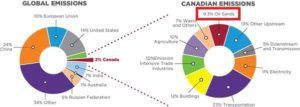Can Innovation Save the Oil Sands?

With new Canadian legislation on carbon emissions on the verge of being ratified, how can the Canadian Oil Sands respond?
Oil Sands producers are feeling the heat as a slew of Canadian and Albertan legislation, focused on carbon emission reduction, has been introduced this past month. In early October, Canadian Prime Minister Justin Trudeau released plans for a nationwide carbon tax plan that would be imposed on Canadian provinces unless they enacted their own local tax plans. This announcement came on the heels of another carbon tax that was introduced by the Alberta government in late 2015, which levied a $20-$30 per tonne tax on carbon emissions in the province of Alberta.
So what does this mean for the oil sands community? In addition to placing additional scrutiny on the environmental impact of the oil sands industry, these proposals directly affect the economics and future of the industry in two meaningful ways:
- Adjusting oil sands carbon emission tax and threshold: Currently Oil Sands producers pay $20 per tonne for carbon emitted beyond a 100,000 tonne/year “theshold” defined as part of a 2007 emissions reduction bill. The proposed legislation would increase the tax rate to $30 per tonne, and adjust the “threshold” to the emission rate of the 25% cleanest producers in the region, effectively penalizing only the most carbon inefficient producers. [2]
- Imposing an overall cap on total carbon emissions: The new legislation would also place a hard cap of 100 megatonnes/year on carbon emissions for the entire Oil Sands industry. Current operations on average emit about 70 megatonnes each year. [2]
The impact of these two provisions is likely to have a long term impact for oil sands producers in the region, including large producers like Cenovus, which contributes 10-15% of the 2.3MM+ barrels of oil produced each day in the region [1]. As comparative, company-specific emissions data is difficult to obtain, it remains to be seen whether Cenovus will be impacted positively or negatively “threshold” adjustment; however the overall emissions cap will significantly shape the future of all oil sands production growth in the region.
 [8]
[8]
Cenovus currently produces ~310 kbbl per day of oil and has 80 kbbl per day of production capacity in construction along with ~500 kbbl per day of oil sands reserves approved for future development [1].With a significantly higher cost of production than conventional oil, producing at greater scale is paramount to oil sands producers like Cenovus, and future opportunities for growth represent a significant asset for the company. With a hard cap on carbon emissions, Cenovus will need to focus on improving its carbon footprint in order to grow in the future.
In response to the introduction of this bill, Brian Ferguson, chief executive officer of Cenovus Energy Inc., said it is “illogical” for Canada “to completely leapfrog over oil,” which is a “fantastic” energy source. Instead, time, effort and money should be used to cut emissions that result from oil production and its use, he said [7]. To this end, Cenovus continues to invest in a series of programs with the goal of reducing carbon emissions in its production process. Four of Cenovus’ biggest investments are below.
- Renewable energy investments. Ferguson says, “Over the next two to three years our prime focus is going to shift to the emissions side of oil, both in terms of production and consumption,” He added that solar will also be an important part of the future energy mix. [1]
- Innovative ways to process bitumen. Cenovus and its competitors are reportedly testing new technologies such as solvents and microwaves to melt bitumen, a pre-processed, highly viscous form of oil. This process that would result in a significantly lower level of carbon emissions. [1]
- Clean-tech investment fund. Cenovus has begun investing in a clean-tech fund that focuses on commercializing technologies that reduce emissions in both the production of oil and its end use. Fergusion has stated, “I absolutely believe that hydrocarbons can be part of a low-carbon future.” [1]
- COSIA, which stands for Canada’s Oil Sands Innovation Alliance, was founded in 2012. Cenovus and 7 other major Oil Sands producers make up COSIA and through it, fund an annual prize to spur ways to reuse CO2 emissions. [6]
The big question is whether this innovation will be enough. With such an immense risk to the livelihood of the company, it is clear that Cenovus needs to position itself both in brand and technology as the leading clean energy provider in the oil sands region. However, at its heart, this challenge remains an operational and scientific one. Cenovus needs to continue to push innovation, but also expand its partnerships with universities and its fellow oil sands producers. In an industry where success is so tightly intertwined, joint research ventures should be more ubiquitous and data should be shared openly. Otherwise, companies like Cenovus run the risk of becoming like the reserves they toil to extract: full of potential, but largely untapped. (794)
Sources:
[1] “Alberta Oil Sands Industry Quarterly Update,” published Summer 2016. Alberta Government. http://www.albertacanada.com/files/albertacanada/AOSID_QuarterlyUpdate_Summer2016.pdf
[2] “Capping Oil Sands Emissions,” Alberta Government, accessed November 3rd. http://www.alberta.ca/climate-oilsands-emissions.aspx
[3] Dean Bennett, “Alberta introduced bill to cap oilsands emissions at 100 megatonnes a year,” Metronews, November 1st, 2016. http://www.metronews.ca/news/canada/2016/11/01/alberta-introduces-bill-to-cap-oilsands-emissions-at-100-megatonnes-a-year.html
[4] Anmar Frangoul, “Canada set to introduce carbon tax,” CNBC, October 4th, 2016. http://www.cnbc.com/2016/10/04/canada-set-to-introduce-a-carbon-tax.html
[5] “Cenvous 2015 Annual Report.” http://www.cenovus.com/invest/docs/2015-annual-report/annual-report-2015.pdf
[6] COSIA website, accessed November 3rd, 2016. http://www.cosia.ca/
[7] Richard Blackwell, “Oil sands can plan role in low-carbon future: Cenovus CEO,” The Globe and Mail, May 27th, 2016. http://www.theglobeandmail.com/report-on-business/industry-news/energy-and-resources/oil-sands-can-play-role-in-low-carbon-future-cenovus-ceo/article30192566/
[8] “GHG Emissions,” Canada’s Oil Sands, accessed November 3rd, 2016. http://www.canadasoilsands.ca/en/explore-topics/ghg-emissions





Its interesting to see how many companies are affected by the environmental concerns in the oil sands (see other post about Suncor Energy). Its heartening to think of how the combined affects of multiple companies (ex. COSIA) could lead to some significant environmental steps forward for the oil sands or other related industries. If many of the world’s top minds are working on this issue I think it is only a matter of time until large strides are made in reducing global emissions.
A well researched article DT. Two thoughts:
1) Regarding company specific emissions data, many public companies are now releasing “Corporate Citizenship Reports” (see ExxonMobil example here: http://corporate.exxonmobil.com/en/community/corporate-citizenship-report) that detail emissions at a fairly granular level. These are self-imposed reports (i.e. not required SEC filing) in response to shareholder demands for more transparency. This is similar to the sustainability discussion we had last week on IKEA.
2) A key financial metric for oil companies is their booked reserves. An investor can look at current production vs. total reserves and get an idea of the longevity of the companies current portfolio – as such, changes to reserves move markets. Due to the low oil price environment, much of the oil in the oil sands is at risk of being debooked as at the current price it will no longer be economically viable to extract. An added carbon tax in Alberta will take a massive economic toll on a region already reeling from the current oil slump and potentially cause a significant degradation in many oil companies financial positions. See this article for a little more info on an ExxonMobil specific example of this type of reserves debooking: https://www.ft.com/content/53f66878-9d13-11e6-a6e4-8b8e77dd083a.
Thanks for the interesting read, DT! I am curious – with a nationwide imposition of an “overall cap” on carbon emissions, how is that 100M tonnes/year allocated between companies (i.e. how do they keep companies accountable to that limit in aggregate, when each company could point a finger at the others)? I would also be interested to see what incremental profit is generated by oil sands companies in Canada from production that results in an additional tonne of carbon emission – is $30 CAD more than enough to cover the incentive to just keep producing inefficiently?
It’s encouraging to see companies like Cenovus investing in innovation through the clean tech fund and bitumen processing, rather than just figuring out workarounds; it seems they are approaching the problem in the right way by thinking about the long term. However, I agree that more needs to be done.
Also, nice wordplay toward the end :-D.